Here we will walk through the Top 10 Steps To Pack Clothes For Moving.
When it comes to packing and moving, clothes are a cinch because they’re light, sturdy, and fit almost anyplace. As for packing clothes for travel or storage, you’re probably a pro. After all, you’ve done it a zillion times already (for vacations, holidays, storage, and so on).
When you open the dresser, though, you’ll notice that things aren’t quite as straightforward as they first appear. You must discover a way to pack your garments in such a way that they are safe and don’t take up too much space so that you can move them easily and quickly.
As it turns out, this isn’t a particularly tough goal to attain. Moving clothes might be a pain, but it doesn’t have to be if you know how to pack them correctly.
1. Clean out your closet and get rid of anything you don’t need. – Top 10 Steps To Pack Clothes For Moving

First, sift through your clothing and get rid of everything that you no longer wear. You have a lot of clothes in your closet, but you don’t need to bring them all with you when you move.
- Clothes you won’t need after the move – Some of your old garments may be rendered unusable if you relocate because of climate differences or significant changes in your way of living. If you’re moving to Florida or the Alps, you won’t need your fur coats or sleeveless outfits. In a huge metropolis, you may as well leave your farmer’s clothing at home, and your cocktail gowns may be of little use if you’re quitting your job at a giant international firm to start a family bakery, for example.
- Outdated clothes – A lot of people’s tastes alter throughout time due to the ever-changing fashion trends. A decade ago, what was fashionable was no longer fashionable, and what reflected your personality may now be entirely out of character.
- Clothes that don’t fit – It doesn’t matter how much you enjoy your old clothes if you can’t fit into them again, so don’t keep them. Children can’t stay in the same clothes for more than two seasons, as every parent knows all too well. Outgrown clothing is not worth the time, effort, and money it takes to move them (and the extra room they will take up), even if you have sentimental value attached to them.
- Worn-out clothes – Some outfits are simply comfier than others, and they appear to be appropriate for any event. But if your favorite products are worn out, you will have to buy new ones sooner or later. Before the transfer, it’s best to get rid of these;
- Clothes you don’t like – The summer dress your cousin gave you for your birthday last year may have nothing wrong with it, but it may just not be your taste and should be put to better use than languishing in your closet for years.
Determine which of your clothing items you want to bring to your new home and which you don’t before you begin packing. Make sure that the item can be used after the move if it fits if it’s fashionable and if it’s in good shape before you buy it. Make use of the one-year rule: if you haven’t worn something in a year, it’s time to get rid of it.
2. Group your clothes – Top 10 Steps To Pack Clothes For Moving
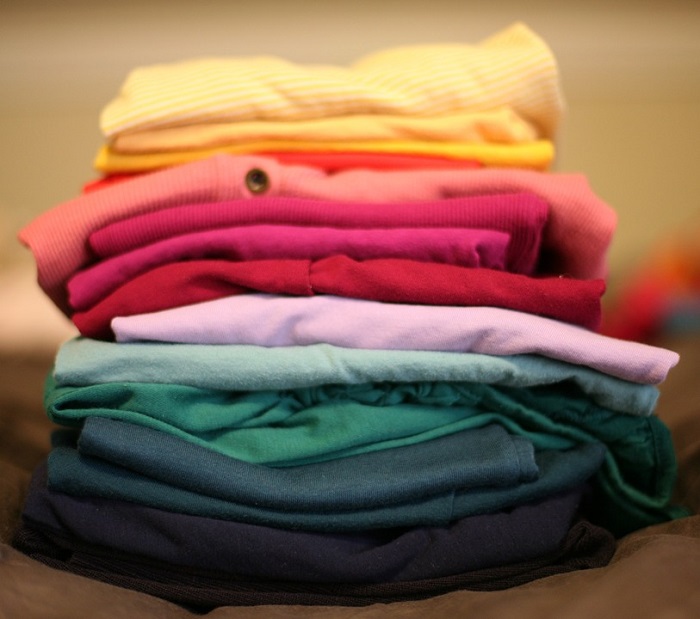
It’s time to organize your clothing once you know what you’ll be taking to your new residence.
You can arrange your clothing in any way that makes sense to you.
a) By material – Sorting your items by material will speed up the packing process because similar textiles have similar packing requirements:
- You’ll need to find a means to preserve natural materials (like cotton) wrinkle-free (or be prepared to iron them after the move) during the moving process.
- To protect delicate materials like silks and leathers, they must be packed carefully.
- Knits and woolen clothing take up a lot of room, making them difficult to store.
- When packing synthetics and polyesters, don’t worry about how tightly they’ll fit in a moving box; they’ll be OK.
b) By season – When moving to a new city, pre-packing out-of-season things will help you to prioritize unpacking (so you can unpack in-season clothing first – according to the time of year when your move takes place and the current weather conditions in your new location). The rest of your clothes can be stored in their boxes and bags until you have more time to unpack them (or until you return home).
c) By type – When packing, it makes a lot of sense to pack comparable items together – such as jeans, shirts, dresses, and so on. As a result, packing and unpacking will be much easier and quicker, and you’ll know where to find any specific clothing items you may require.
d) By purpose – As a rule of thumb, it’s best to pack your most frequently worn clothing in a different container from your formal attire and specialist apparel, which may not be needed for some time after your relocation. One of the easiest ways to keep clothing organized and ready for use is to classify items according to their intended function (sportswear, workplace attire, homeware, etc.).
3. Before the relocation, put away any clothes you don’t plan on using.
Sorting through your clothing will help you choose which items you won’t need when you move. These clothes are best packed ahead of time so that you may save some time during the last few weeks before your move:
- Out-of-season clothes – It’s a good idea to start packing your winter items ahead of time if you’re relocating in the summer. It’s also a good idea to pack your summer clothes in advance if you’re relocating in the winter.
- Specialty clothes – To ensure that you don’t forget anything, it is a good idea to pack everything you won’t wear before your move, such as your business dress if you won’t be attending any formal events, your hiking gear if you won’t have time to go hiking, etc.
4. Put aside the clothes you’ll need during your relocation
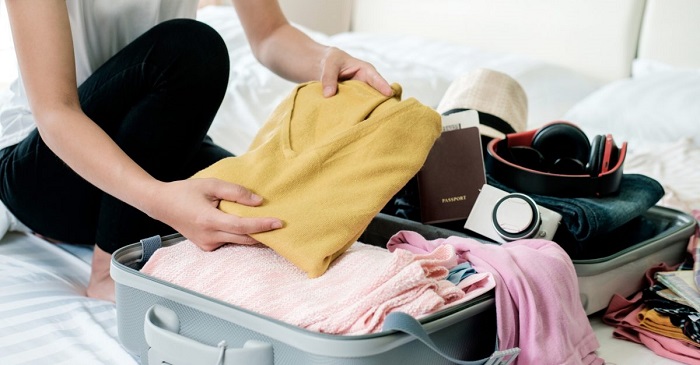
Make a mental note of the items you’ll need before, during, and soon following your move, and keep them separate from the rest of your wardrobe:
- Choose your outfit on moving day – Make sure you’re dressed comfortably so you may move around freely while also protecting yourself from the elements. Take into mind the weather when selecting your wedding attire and prepare for any unforeseen meteorological conditions (for example, what if it suddenly starts raining?).
- Prepare your basics bag with the clothes you’ll need the moment you arrive. – Moving can be exhausting, so make sure that you have some towels, undergarments, and pajamas on hand so that you can wash and get some shut-eye after a long day of packing (so they travel with you). For long-distance moves, don’t forget to pack a change of clothes in your basics bag so that you don’t have to worry about running out of things to wear.
Finally, you’re ready to begin the actual process of putting away your clothes. You can pack your clothes in a variety of ways, some of which are better suited to certain types of clothing, some are only appropriate in certain scenarios and yet other methods work every time. How to pack your clothes for moving relies on the type of clothing and the circumstances of your move.
5. How to pack hung clothing for a move

Just leave your hanging clothing on their hangers when you’re packing them for relocation. So how do you pack things on hangers?
Use wardrobe boxes
Clothes that are on hangers are best transported in wardrobe boxes. There are several specialist wardrobe boxes on the market that allow you to simply remove your hanging garments from the closet and put them directly into the box, hanging them on the metal rod that is attached to the top of the box. That’s all there is to it.
Besides that, wardrobe boxes are a great way to maintain your clothes wrinkle-free and prevent them from dust, grime, and other damages.
This strategy is ideal for packing expensive and fragile apparel, as well as formal wear such as suits and gowns, as well as boutique items.
Wardrobe boxes, on the other hand, can be costly and take up a lot of room.
Use garment bags
Garment bags are specifically made for transporting garments on hangers; they come in a variety of sizes and contain a clasp that attaches individual hangers.
Garment bags, like wardrobe boxes, are ideal for transporting expensive apparel. However, they are also rather pricey — and only hold a few pieces of clothing.
Use trash bags
One of the finest ways to pack hanging clothing for a move is to put them in garbage bags. Because they don’t take up any room, garbage bags will save you time and work – and even some money.
Garbage bags are a great way to store your clothing. All you have to do is cut a hole at the bottom of a clean drawstring trash bag large enough to accommodate the hangers, then pull the bag over a dozen items that are already hanging. Just pull the drawstring to keep the clothing in the bag in place and wrap a twist knot over the hangers to keep them in place.
Packing clothes in plastic bags may be quick and convenient; but, they come with a price: plastic bags shred easily and offer very little protection for the clothing they hold. Aside from that, they’re slick and difficult to keep in place once put on.
Use plastic wrap or sheets
Wrapping a bunch of garments in plastic film and getting them ready for transport is another simple and effective technique to pack clothes on hangers.
Plastic wrap can wrap around any length of clothes and a huge number of items. However, it shreds and dissolves just as quickly as trash bags.
Packing tape is all that is needed to secure bundles of sheets wrapped around hung clothing. The soft covering will protect your clothing better and the bundles will not be sluggish because of it.
6. How to pack folded clothes for moving
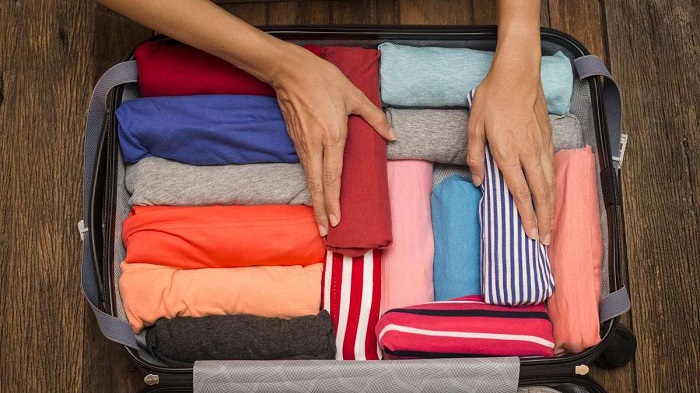
A dresser is the easiest way to transfer folded clothes. They can be stored in any moving container (such as baggage or boxes).
So long as the wardrobe is solid, clothes can be lifted and carried without being flipped or tilted.
As a result, you must empty the dresser before the relocation if it is too heavy or fragile, or if it cannot be moved in an upright position.
If you’re relocating, you’ll need to remove your hanging clothes from the wardrobe and pack them in one of the following ways.
Although you will have to remove the drawers from the dresser, you will still be able to use them as moving containers for your folded clothes. In addition to saving you time and effort, this packing tip will also save you valuable real estate. It’s important to wrap the drawers in stretch wrap to keep your items safe from dust and filth.
>> Related Articles: TOP 5 CREATIVE WAYS TO ANNOUNCE PEOPLE YOU ARE MOVING
7. The best way to pack your clothes for a move
The easiest way to answer the question, “How do I pack my clothes for a move?” is to think about several ways to pack your clothes.
How to pack clothes in boxes
For moving, cardboard boxes are the most common packing containers, thus it makes sense to put clothes in boxes.
Packing clothes in a moving box follow these steps:
- Using a strong, clean cardboard box of medium size, begin to assemble it.
- Packing paper should be placed on the bottom of the container.
- Put your garments in the box after they have been folded flat. To avoid tripping over delicate garments, position heavier ones at the bottom and lighter ones higher up.
- Put several sheets of packing paper over the garments to keep them from becoming wet.
- Put the box away, tape it up, and use a permanent marker to name it.
How to pack clothes in a suitcase
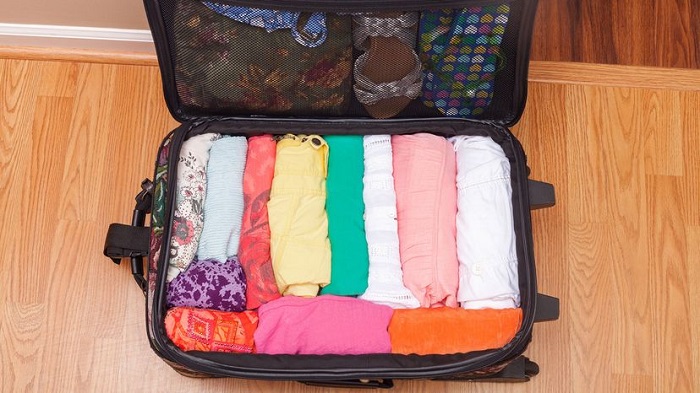
Suitcases are designed to transport and protect clothing, therefore they’re the greatest choice for moving garments. To fit all of your clothing into your baggage, you’ll have to choose which items to pack.
Suitcases are ideal for transporting both delicate and heavy clothing, as they offer good protection for the items inside (as they have wheels and can be easily moved around).
To keep yourself warm and dry while you await the arrival of your goods and the rest of your clothing, it’s a good idea to pack a few essentials in carry-on luggage that you’ll be taking with you.
Whether you fold, roll, or use packing cubes, the first thing to remember when packing clothes for a trip is to place the heaviest items at the bottom of the luggage.
How to pack clothes in a duffel bag
One of the most convenient ways to transport clothing is to use a duffel bag. In a duffel bag, roll your clothes with the long side facing the bag’s long edge (see below).
How to bundle wrap clothes
Bundle wrapping is a whole new way to pack your clothes for a move, as opposed to using moving containers like boxes, bags, and luggage.
This is a new way to pack garments that are designed to keep them wrinkle-free and conserve space. In this method, you begin by stacking your clothes and then folding them around a central core piece to create a bundle that is both compact and wrinkle-free.
- A “core” made of small, soft clothing items like socks and underpants can be made.
- Set an item of clothing on a level surface, such as a jacket.
- Dresses, slacks, skirts, shirts, blouses, and other smaller clothing items should be piled on top of each other.
- The core should be placed in the middle of the stacked garments.
- The process is complete when all objects are wrapped with the largest piece of clothing.
>> Related Articles: TOP 10 WAYS THE FINAL MOVING COST CAN BE INCREASED
8. How to pack clothes to save space
Because packing clothes for a move can take up a significant amount of room, you’ll want to make every effort to reduce the amount of space they occupy. The less space they occupy, the quicker and less expensive your move will be.
Roll up your clothes
Rolling your clothes is a terrific technique to save room while packing for a move, even if it’s hard to imagine that rolled clothing items occupy half as much space as folded clothing items. To make it easier, lay a piece on its front and roll it up from the bottom. Shirts and pants should have their sleeves rolled back when folded, and pants should be folded in half vertically. Rubber bands can help keep your garments rolled up.
You’ll be astonished at how many clothes roll your duffel bags and luggage can accommodate.
Use packing cubes
Moving can be a time-consuming process without the use of packing cubes, which compacts and organize your belongings for easier unpacking.
If you’re using packing cubes, the idea is to cram as many similar-looking garments as you can into a single cube before zipping it up for transportation. Before putting your garments in the packing cubes, roll them up to save room.
However, keep in mind that this procedure is not suitable for delicate or formal garments.
Use vacuum bags
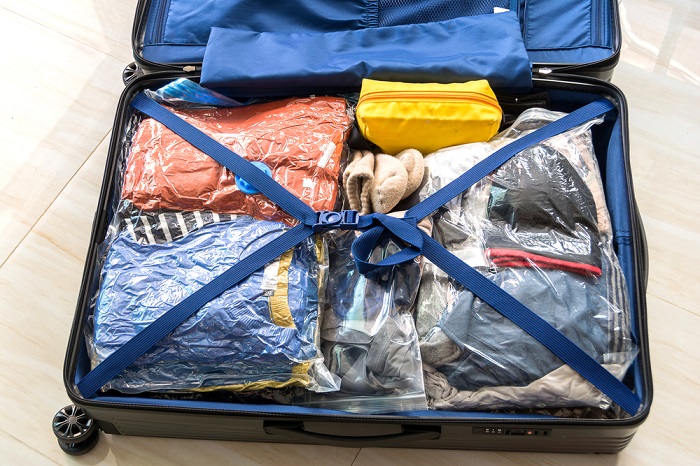
There is no better way to compress bulky, soft objects (such as clothing and bedding) than vacuum bags. These bags are specifically intended to do just that.
However, how do you stuff your things in a vacuum bag?? Clothes are instantly deflated with a suction hose or (there is a special valve on the side of the bag that allows you to do that). By sucking the air out of your vacuum bag, you free up space in your car.
>> Related Articles: TOP 10 TIPS TO MOVE BY YOURSELF
9. How to pack clothes without wrinkles
Avoid squashing garments in their containers to avoid wrinkling (as crushing the fabric inevitably results in increases).
You can accomplish this by:
- The easiest way to keep your clothes wrinkle-free is to bundle them in a tight bundle, with the more wrinkle-prone garments on the exterior.
- You must roll your clothes tightly and evenly to prevent them from wrinkling.
- Stuffing the folds with tissue paper to keep the clothes from rubbing against each other or each other when folded.
- Individual plastic dry-cleaning bags (to create an air cushion around the garments to prevent friction);
- When relocating, utilize wardrobe boxes or garment bags to protect your clothes.
- Avoiding suffocation when packing (to prevent clothing from being crushed during transit);
- To avoid the clothes in your moving container from rubbing against each other and fluttering around, prevent them from shifting.
- Putting heavier items on the bottom of the container to avoid crushing lighter items; not placing any items on top of the clothing to avoid putting pressure on the clothing;
- Compression bags and cubes are not necessary.
Moving is stressful enough, but knowing how to pack clothes without wrinkling them will save you time once you arrive.
>> Related Articles: TOP 9 TIPS TO PACK FRAGILE ITEMS FOR MOVING
10. Final tips for packing clothes when moving
When packing for a move, there are a few more things to keep in mind:
a) Before you begin packing your clothes for a move, make sure they are clean and dry. So make sure your clothes are completely dry before storing them in boxes, bags, or suitcases. Wash or dry-clean all clothing before packing to reduce odors, dust, and filth in boxes and luggage.
b) Fold your clothes with the insides out. Clothes will be flipped to make straightening easier.
c) Clothing storage containers should be sprayed with an insecticide. Pack an insect repellent with your clothes if you plan to store them for a while before unpacking. Moths and other insects are easily drawn to certain materials, so protect your clothing.
d) Pack hats and other items separately. Preserve the hats by packing them in large boxes with lots of padding. Paper should be packed into fragile, non-stackable hats. Small boxes with padding inside are ideal for storing and transporting accessories.
e) You can use old clothing to fill in the gaps in your packing containers, to line the bottoms of your boxes, to stuff hollow items, to wrap fragile items, and more.
>> Related Articles: TOP 3 EASY TIPS TO MOVE WITH YOUR DOG: EASING YOUR PET’S TRANSITION INTO THEIR NEW HOME



